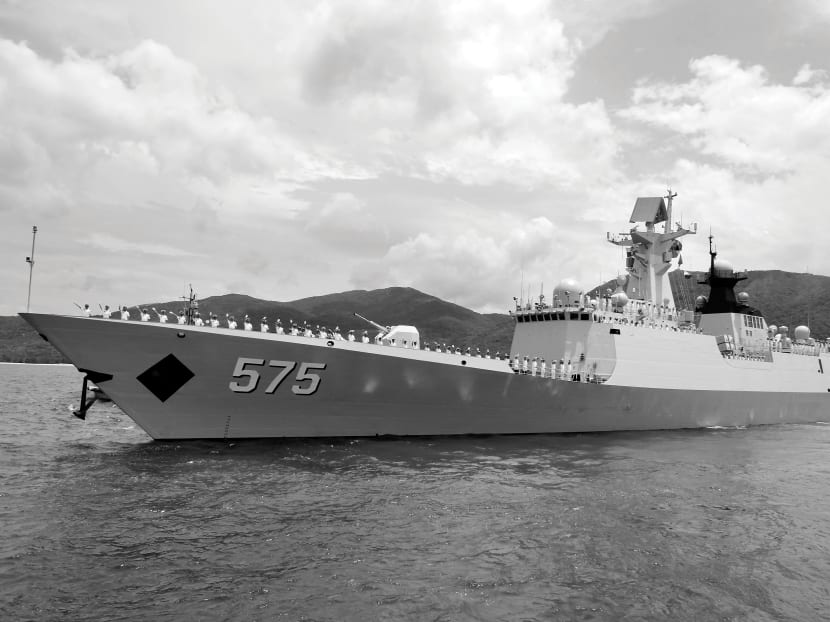Submarines grow in strategic importance for regional navies
Notwithstanding East Asia’s economic growth rates and deepening integration into the global economy, the region’s strategic realities reflect contending trajectories.

China’s PLA Navy is transforming towards a regional defensive and offensive type navy with extended A2/AD capabilities and defensive and offensive air power. PHOTO: REUTERS
Notwithstanding East Asia’s economic growth rates and deepening integration into the global economy, the region’s strategic realities reflect contending trajectories.
As China expands its national interests in the broader context of “new historic missions”, it seeks to regain a great power status and reassert its geopolitical role in the region. As a result of China’s accelerating military modernisation, regional powers are responding by revamping their force-modernisation priorities, alliances and overall strategic choices.
The economic, political and military rise of China, embedded in three decades of relentless Chinese economic growth, has propelled progressive modernisation of the Chinese military with major improvements in virtually every capability domain.
MODERNISING CHINA’S NAVY AND SUBMARINES
Notwithstanding weaknesses and limitations in capabilities integration, China’s PLA Navy (PLAN) is gradually transforming itself towards a regional (blue water) defensive and offensive type navy with extended so-called anti-access/area-denial (A2/AD) capabilities, limited expeditionary capabilities, and corresponding defensive and offensive air power. China calls its comprehensive A2/AD strategy a “counter-intervention”, which is interpreted as denying the United States and its allies the freedom of action in China’s “near seas” by restricting their deployments into theatre (anti access) and denying them freedom of movement there (area denial).
An important aspect of China’s multilayered strategy is the gradual introduction of new classes of submarines — both nuclear and conventional. China is currently operating as many as 45 submarines structured in six different classes: Two classes of indigenously-designed diesel submarines, including the Song class (Type 039) and the Yuan class (Type 041), and four nuclear classes that include the Shang class (Type 093), Jin class (Type 094) nuclear-powered ballistic missile submarines (SSBN) and the follow-on Type 095 nuclear-powered attack submarine (SSN) and Tang class (Type 096) SSBN.
Since 2004, China is believed to have launched 12 Type 041 Yuan-class conventional submarines, which have been progressively modified to carry more advanced high-frequency sonar, upgraded weapons systems, noise reduction and air independent propulsion (AIP) technologies. The PLA Navy may procure up to 20 additional Yuan-class submarines based on technologies imported from Russian boats. Since the mid-1990s, China has procured as many as 12 Kilo-class submarines from Russia, and is reportedly negotiating the purchase of at least four fourth-generation Amur (Lada)-class or possibly a fifth-generation Kalina-class, both featuring advanced AIP systems.
HOW THE REGION IS RESPONDING
In North-east Asia, Japan and South Korea are prioritising the procurement of new types of submarines. In September 2013, South Korea launched a fourth 1,800-tonne Son Won-il-class (German Type 214) submarine, featuring AIP and combat management systems. South Korea now operates 13 submarines: Nine Type 209 Chang and four Son Won-il-class submarines.
Meanwhile, in October 2013, the Japan Marine Self Defense Force (MSDF) launched its newest submarine, the Kokuryu — the sixth of a planned 10 Soryu-class boats first commissioned in 2009. With its range, endurance, sensors, weapons load and other systems, including the Stirling AIP propulsion system and Harpoon anti-ship missiles, the Soryu class is regarded as the most advanced in Japan’s conventional submarine fleet of 16 submarines.
In South-east Asia, the relatively high acquisition costs and maintenance requirements have traditionally precluded a quantitative diffusion of submarines. However, the recent introduction of more-capable coastal diesel-powered submarines provides unprecedented capabilities.
Most recently, Vietnam received two of six Kilo-class (Project 636) diesel-electric submarines from Russia in 2013- 2014, designed for diverse reconnaissance and patrol, anti-submarine and anti-ship missions.
Indonesia, Malaysia and Singapore are also planning to expand or upgrade their submarine fleets. From 2007 to 2009, Malaysia took formal delivery of two French-built Scorpene-class submarines, equipped with underwater-launched Exocet anti-ship missiles. Both submarines are based at the Kota Kinabalu Naval Base in Sabah, East Malaysia, indicating their primary mission to protect Malaysia’s sovereignty in parts of the South China Sea. Meanwhile, Indonesia has ambitious plans to expand its submarine fleet to at least six, and ideally to 12 by 2024, a key element in the “Minimum Essential Force” (MEF) and declared goal of developing a “green-water” navy. In 2012, the Indonesian Navy (TNI-AL) announced a US$1.1 billion (S$1.37 billion) contract for three Type-209/1400 diesel-electric submarines, constructed by South Korea’s Daewoo Shipbuilding and Marine Engineering.
In November 2013, Singapore announced a contract with German shipbuilder ThyssenKrupp to acquire two advanced Type-218SG submarines that will augment existing Archer-class boats and replace ageing ex-Swedish Challenger-class by 2020.
Type-218SG, designed for littoral, shallow-sea operations, is a customised design that will integrate features from Type 214 and possibly Type 216 “concept submarine” fitted with fuel-cell AIP system.
STRATEGIC RAMIFICATIONS
Over the past decade, the operational utility of submarines in East Asia has widened: From anti-submarine warfare to force protection such as close submarine escort missions, intelligence surveillance and reconnaissance to support of Special Forces, and other complementary deterrence and defensive tasks supporting territorial defence.
At the same time, the introduction of submarine-launched anti-ship and land-attack cruise missiles, anti-submarine sensors and weapons, as well as air-independent propulsion systems, have increased their stealth capacity to remain undetected, shortened their target-identification-and-attack cycle and, ultimately, improved their flexibility, mobility, endurance, reach and lethality.
For smaller, defensively-oriented navies in East and South-east Asia, these attributes enable “sea-denial” capabilities aimed at preventing an opponent from using the sea, rather than providing a degree of sea control to use the sea for own-power projection. Submarines will therefore become an increasingly valuable strategic asset in the region, particularly with installed AIP systems. The key difference, however, will be in the experience, training and skill set of their operators.
ABOUT THE AUTHOR:
Dr Michael Raska is a research fellow at the Institute of Defence and Strategic Studies, a constituent unit of the S Rajaratnam School of International Studies (RSIS), Nanyang Technological University in Singapore. This commentary first appeared in RSIS Commentaries.






